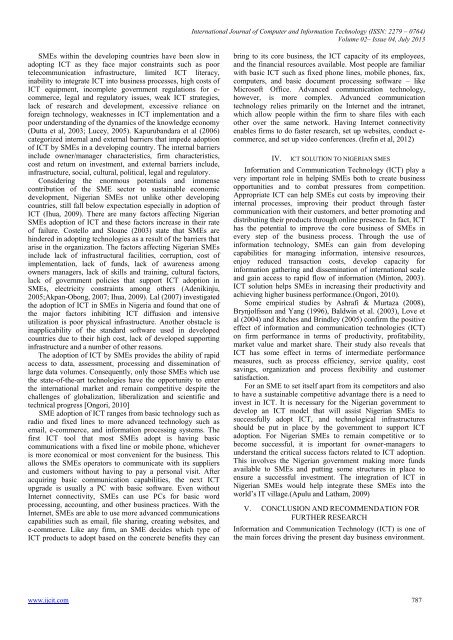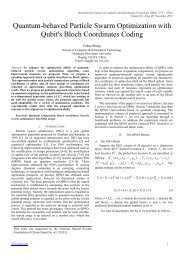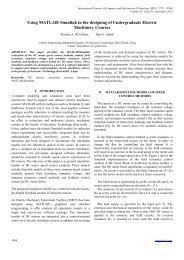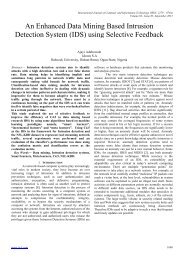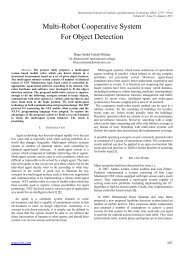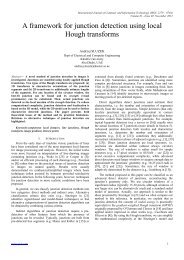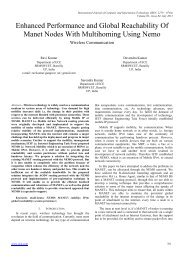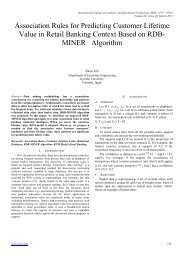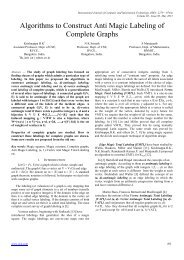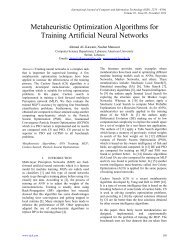ICT solution to Small and Medium Scale Enterprises (SMEs) in Nigeria
ICT solution to Small and Medium Scale Enterprises (SMEs) in Nigeria
ICT solution to Small and Medium Scale Enterprises (SMEs) in Nigeria
Create successful ePaper yourself
Turn your PDF publications into a flip-book with our unique Google optimized e-Paper software.
International Journal of Computer <strong>and</strong> Information Technology (ISSN: 2279 – 0764)<br />
Volume 02– Issue 04, July 2013<br />
<strong>SMEs</strong> with<strong>in</strong> the develop<strong>in</strong>g countries have been slow <strong>in</strong><br />
adopt<strong>in</strong>g <strong>ICT</strong> as they face major constra<strong>in</strong>ts such as poor<br />
telecommunication <strong>in</strong>frastructure, limited <strong>ICT</strong> literacy,<br />
<strong>in</strong>ability <strong>to</strong> <strong>in</strong>tegrate <strong>ICT</strong> <strong>in</strong><strong>to</strong> bus<strong>in</strong>ess processes, high costs of<br />
<strong>ICT</strong> equipment, <strong>in</strong>complete government regulations for e-<br />
commerce, legal <strong>and</strong> regula<strong>to</strong>ry issues, weak <strong>ICT</strong> strategies,<br />
lack of research <strong>and</strong> development, excessive reliance on<br />
foreign technology, weaknesses <strong>in</strong> <strong>ICT</strong> implementation <strong>and</strong> a<br />
poor underst<strong>and</strong><strong>in</strong>g of the dynamics of the knowledge economy<br />
(Dutta et al, 2003; Lucey, 2005). Kapurub<strong>and</strong>ara et al (2006)<br />
categorized <strong>in</strong>ternal <strong>and</strong> external barriers that impede adoption<br />
of <strong>ICT</strong> by <strong>SMEs</strong> <strong>in</strong> a develop<strong>in</strong>g country. The <strong>in</strong>ternal barriers<br />
<strong>in</strong>clude owner/manager characteristics, firm characteristics,<br />
cost <strong>and</strong> return on <strong>in</strong>vestment, <strong>and</strong> external barriers <strong>in</strong>clude,<br />
<strong>in</strong>frastructure, social, cultural, political, legal <strong>and</strong> regula<strong>to</strong>ry.<br />
Consider<strong>in</strong>g the enormous potentials <strong>and</strong> immense<br />
contribution of the SME sec<strong>to</strong>r <strong>to</strong> susta<strong>in</strong>able economic<br />
development, <strong>Nigeria</strong>n <strong>SMEs</strong> not unlike other develop<strong>in</strong>g<br />
countries, still fall below expectation especially <strong>in</strong> adoption of<br />
<strong>ICT</strong> (Ihua, 2009). There are many fac<strong>to</strong>rs affect<strong>in</strong>g <strong>Nigeria</strong>n<br />
<strong>SMEs</strong> adoption of <strong>ICT</strong> <strong>and</strong> these fac<strong>to</strong>rs <strong>in</strong>crease <strong>in</strong> their rate<br />
of failure. Costello <strong>and</strong> Sloane (2003) state that <strong>SMEs</strong> are<br />
h<strong>in</strong>dered <strong>in</strong> adopt<strong>in</strong>g technologies as a result of the barriers that<br />
arise <strong>in</strong> the organization. The fac<strong>to</strong>rs affect<strong>in</strong>g <strong>Nigeria</strong>n <strong>SMEs</strong><br />
<strong>in</strong>clude lack of <strong>in</strong>frastructural facilities, corruption, cost of<br />
implementation, lack of funds, lack of awareness among<br />
owners managers, lack of skills <strong>and</strong> tra<strong>in</strong><strong>in</strong>g, cultural fac<strong>to</strong>rs,<br />
lack of government policies that support <strong>ICT</strong> adoption <strong>in</strong><br />
<strong>SMEs</strong>, electricity constra<strong>in</strong>ts among others (Adenik<strong>in</strong>ju,<br />
2005;Akpan-Obong, 2007; Ihua, 2009). Lal (2007) <strong>in</strong>vestigated<br />
the adoption of <strong>ICT</strong> <strong>in</strong> <strong>SMEs</strong> <strong>in</strong> <strong>Nigeria</strong> <strong>and</strong> found that one of<br />
the major fac<strong>to</strong>rs <strong>in</strong>hibit<strong>in</strong>g <strong>ICT</strong> diffusion <strong>and</strong> <strong>in</strong>tensive<br />
utilization is poor physical <strong>in</strong>frastructure. Another obstacle is<br />
<strong>in</strong>applicability of the st<strong>and</strong>ard software used <strong>in</strong> developed<br />
countries due <strong>to</strong> their high cost, lack of developed support<strong>in</strong>g<br />
<strong>in</strong>frastructure <strong>and</strong> a number of other reasons.<br />
The adoption of <strong>ICT</strong> by <strong>SMEs</strong> provides the ability of rapid<br />
access <strong>to</strong> data, assessment, process<strong>in</strong>g <strong>and</strong> dissem<strong>in</strong>ation of<br />
large data volumes. Consequently, only those <strong>SMEs</strong> which use<br />
the state-of-the-art technologies have the opportunity <strong>to</strong> enter<br />
the <strong>in</strong>ternational market <strong>and</strong> rema<strong>in</strong> competitive despite the<br />
challenges of globalization, liberalization <strong>and</strong> scientific <strong>and</strong><br />
technical progress [Ongori, 2010]<br />
SME adoption of <strong>ICT</strong> ranges from basic technology such as<br />
radio <strong>and</strong> fixed l<strong>in</strong>es <strong>to</strong> more advanced technology such as<br />
email, e-commerce, <strong>and</strong> <strong>in</strong>formation process<strong>in</strong>g systems. The<br />
first <strong>ICT</strong> <strong>to</strong>ol that most <strong>SMEs</strong> adopt is hav<strong>in</strong>g basic<br />
communications with a fixed l<strong>in</strong>e or mobile phone, whichever<br />
is more economical or most convenient for the bus<strong>in</strong>ess. This<br />
allows the <strong>SMEs</strong> opera<strong>to</strong>rs <strong>to</strong> communicate with its suppliers<br />
<strong>and</strong> cus<strong>to</strong>mers without hav<strong>in</strong>g <strong>to</strong> pay a personal visit. After<br />
acquir<strong>in</strong>g basic communication capabilities, the next <strong>ICT</strong><br />
upgrade is usually a PC with basic software. Even without<br />
Internet connectivity, <strong>SMEs</strong> can use PCs for basic word<br />
process<strong>in</strong>g, account<strong>in</strong>g, <strong>and</strong> other bus<strong>in</strong>ess practices. With the<br />
Internet, <strong>SMEs</strong> are able <strong>to</strong> use more advanced communications<br />
capabilities such as email, file shar<strong>in</strong>g, creat<strong>in</strong>g websites, <strong>and</strong><br />
e-commerce. Like any firm, an SME decides which type of<br />
<strong>ICT</strong> products <strong>to</strong> adopt based on the concrete benefits they can<br />
br<strong>in</strong>g <strong>to</strong> its core bus<strong>in</strong>ess, the <strong>ICT</strong> capacity of its employees,<br />
<strong>and</strong> the f<strong>in</strong>ancial resources available. Most people are familiar<br />
with basic <strong>ICT</strong> such as fixed phone l<strong>in</strong>es, mobile phones, fax,<br />
computers, <strong>and</strong> basic document process<strong>in</strong>g software – like<br />
Microsoft Office. Advanced communication technology,<br />
however, is more complex. Advanced communication<br />
technology relies primarily on the Internet <strong>and</strong> the <strong>in</strong>tranet,<br />
which allow people with<strong>in</strong> the firm <strong>to</strong> share files with each<br />
other over the same network. Hav<strong>in</strong>g Internet connectivity<br />
enables firms <strong>to</strong> do faster research, set up websites, conduct e-<br />
commerce, <strong>and</strong> set up video conferences. (Iref<strong>in</strong> et al, 2012)<br />
IV.<br />
<strong>ICT</strong> SOLUTION TO NIGERIAN SMES<br />
Information <strong>and</strong> Communication Technology (<strong>ICT</strong>) play a<br />
very important role <strong>in</strong> help<strong>in</strong>g <strong>SMEs</strong> both <strong>to</strong> create bus<strong>in</strong>ess<br />
opportunities <strong>and</strong> <strong>to</strong> combat pressures from competition.<br />
Appropriate <strong>ICT</strong> can help <strong>SMEs</strong> cut costs by improv<strong>in</strong>g their<br />
<strong>in</strong>ternal processes, improv<strong>in</strong>g their product through faster<br />
communication with their cus<strong>to</strong>mers, <strong>and</strong> better promot<strong>in</strong>g <strong>and</strong><br />
distribut<strong>in</strong>g their products through onl<strong>in</strong>e presence. In fact, <strong>ICT</strong><br />
has the potential <strong>to</strong> improve the core bus<strong>in</strong>ess of <strong>SMEs</strong> <strong>in</strong><br />
every step of the bus<strong>in</strong>ess process. Through the use of<br />
<strong>in</strong>formation technology, <strong>SMEs</strong> can ga<strong>in</strong> from develop<strong>in</strong>g<br />
capabilities for manag<strong>in</strong>g <strong>in</strong>formation, <strong>in</strong>tensive resources,<br />
enjoy reduced transaction costs, develop capacity for<br />
<strong>in</strong>formation gather<strong>in</strong>g <strong>and</strong> dissem<strong>in</strong>ation of <strong>in</strong>ternational scale<br />
<strong>and</strong> ga<strong>in</strong> access <strong>to</strong> rapid flow of <strong>in</strong>formation (M<strong>in</strong><strong>to</strong>n, 2003).<br />
<strong>ICT</strong> <strong>solution</strong> helps <strong>SMEs</strong> <strong>in</strong> <strong>in</strong>creas<strong>in</strong>g their productivity <strong>and</strong><br />
achiev<strong>in</strong>g higher bus<strong>in</strong>ess performance.(Ongori, 2010).<br />
Some empirical studies by Ashrafi & Murtaza (2008),<br />
Brynjolfsson <strong>and</strong> Yang (1996), Baldw<strong>in</strong> et al. (2003), Love et<br />
al (2004) <strong>and</strong> Ritches <strong>and</strong> Br<strong>in</strong>dley (2005) confirm the positive<br />
effect of <strong>in</strong>formation <strong>and</strong> communication technologies (<strong>ICT</strong>)<br />
on firm performance <strong>in</strong> terms of productivity, profitability,<br />
market value <strong>and</strong> market share. Their study also reveals that<br />
<strong>ICT</strong> has some effect <strong>in</strong> terms of <strong>in</strong>termediate performance<br />
measures, such as process efficiency, service quality, cost<br />
sav<strong>in</strong>gs, organization <strong>and</strong> process flexibility <strong>and</strong> cus<strong>to</strong>mer<br />
satisfaction.<br />
For an SME <strong>to</strong> set itself apart from its competi<strong>to</strong>rs <strong>and</strong> also<br />
<strong>to</strong> have a susta<strong>in</strong>able competitive advantage there is a need <strong>to</strong><br />
<strong>in</strong>vest <strong>in</strong> <strong>ICT</strong>. It is necessary for the <strong>Nigeria</strong>n government <strong>to</strong><br />
develop an <strong>ICT</strong> model that will assist <strong>Nigeria</strong>n <strong>SMEs</strong> <strong>to</strong><br />
successfully adopt <strong>ICT</strong>, <strong>and</strong> technological <strong>in</strong>frastructures<br />
should be put <strong>in</strong> place by the government <strong>to</strong> support <strong>ICT</strong><br />
adoption. For <strong>Nigeria</strong>n <strong>SMEs</strong> <strong>to</strong> rema<strong>in</strong> competitive or <strong>to</strong><br />
become successful, it is important for owner-managers <strong>to</strong><br />
underst<strong>and</strong> the critical success fac<strong>to</strong>rs related <strong>to</strong> <strong>ICT</strong> adoption.<br />
This <strong>in</strong>volves the <strong>Nigeria</strong>n government mak<strong>in</strong>g more funds<br />
available <strong>to</strong> <strong>SMEs</strong> <strong>and</strong> putt<strong>in</strong>g some structures <strong>in</strong> place <strong>to</strong><br />
ensure a successful <strong>in</strong>vestment. The <strong>in</strong>tegration of <strong>ICT</strong> <strong>in</strong><br />
<strong>Nigeria</strong>n <strong>SMEs</strong> would help <strong>in</strong>tegrate these <strong>SMEs</strong> <strong>in</strong><strong>to</strong> the<br />
world’s IT village.(Apulu <strong>and</strong> Latham, 2009)<br />
V. CONCLUSION AND RECOMMENDATION FOR<br />
FURTHER RESEARCH<br />
Information <strong>and</strong> Communication Technology (<strong>ICT</strong>) is one of<br />
the ma<strong>in</strong> forces driv<strong>in</strong>g the present day bus<strong>in</strong>ess environment.<br />
www.ijcit.com 787


